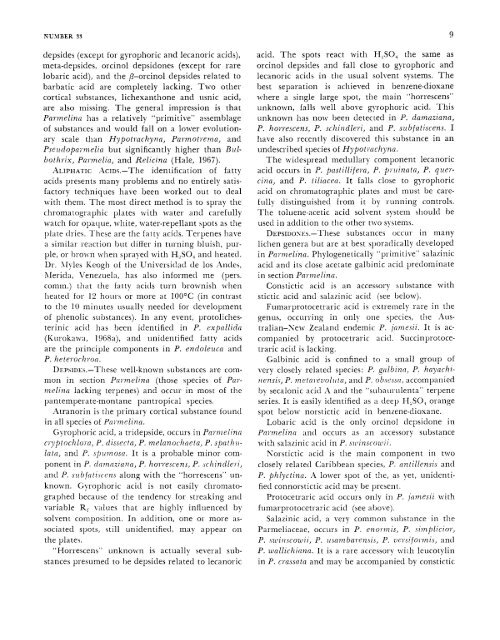A Monograph of the Lichen Genus Parmelina Hale - Smithsonian ...
A Monograph of the Lichen Genus Parmelina Hale - Smithsonian ...
A Monograph of the Lichen Genus Parmelina Hale - Smithsonian ...
Create successful ePaper yourself
Turn your PDF publications into a flip-book with our unique Google optimized e-Paper software.
NUMBER 33<br />
depsides (except for gyrophoric and lecanoric acids),<br />
meta-depsides, orcinol depsidones (except for rare<br />
lobaric acid), and <strong>the</strong> p-orcinol depsides related to<br />
barbatic acid are completely lacking. Two o<strong>the</strong>r<br />
cortical substances, lichexanthone and usnic acid,<br />
are also missing. The general impression is that<br />
<strong>Parmelina</strong> has a relatively “primitive” assemblage<br />
<strong>of</strong> substances and would fall on a lower evolutionary<br />
scale than Hypotrachyna, Parmotrerna, and<br />
Pseudopamelia but significantly higher than Bzilbothrix,<br />
Painzelia, and Relicina (<strong>Hale</strong>, 1967).<br />
ALIPHATIC L\cIDs.-The identification <strong>of</strong> fatty<br />
acids presents many problems and no entirely satisfactory<br />
techniques have been worked out to deal<br />
with <strong>the</strong>m. The most direct method is to spray <strong>the</strong><br />
chromatographic plates ivith water and carefully<br />
watch for opaque, white, water-repellant spots as <strong>the</strong><br />
plate dries. These are <strong>the</strong> fatty acids. Terpenes have<br />
a similar reaction but differ in turning bluish, purple,<br />
or I~roivn when sprayed with H,SO, and heated.<br />
Dr. AIyles Keogh <strong>of</strong> <strong>the</strong> Universitlatl de 10s Andes,<br />
hlerida, Venefuela, has also informed me (pers.<br />
comm.) that <strong>the</strong> fatty acids turn brownish when<br />
heated for 12 hours or more at 100°C (in contrast<br />
to <strong>the</strong> 10 minutes usually needed for development<br />
<strong>of</strong> phenolic substances). In any event, protolichesterinic<br />
acid has been identified in P. expallida<br />
(Kurokawa, 1968a), and unidentified fatty acids<br />
are <strong>the</strong> principle components in P. endolezica and<br />
P. !let ei.ochloti.<br />
hPsmEs.-These well-known substances are common<br />
in section Pamwlina (those species <strong>of</strong> <strong>Parmelina</strong><br />
lacking terpenes) and occur in most <strong>of</strong> <strong>the</strong><br />
pantemperate-montane pantropical species.<br />
Atranorin is <strong>the</strong> primary cortical substance found<br />
in all species <strong>of</strong> Paymelina.<br />
Gyrophoric acid, a tridepside, occurs in Paimelinn<br />
cryptochlora, P. dissecta, P. melanochaeta, P. spnthirhta,<br />
and P. spztrnosu. It is a probable minor component<br />
in P. tlninnziana, P. horl-escens, P. .schindlei~i,<br />
ancl P. subfritiscen.s along with <strong>the</strong> “horrescens” unknown.<br />
Gyrophoric acid is not easily chromatographed<br />
because <strong>of</strong> <strong>the</strong> tendency for streaking antl<br />
variable R, values that are highly influenced by<br />
solvent composition. In addition, one or more associated<br />
spots, still unidentified, may appear on<br />
<strong>the</strong> plates.<br />
“Horrescens” unknown is actually several substances<br />
presumed to be depsides related to lecanoric<br />
acid. The spots react with H,SO, <strong>the</strong> same as<br />
orcinol depsides and fall close to gyrophoric and<br />
lecanoric acids in <strong>the</strong> usual solvent systems. The<br />
best separation is achieved in benzene-dioxane<br />
where a single large spot, <strong>the</strong> main “horrescens”<br />
unknown, falls well above gyrophoric acid. This<br />
unknown has now been detected in P. damaziana,<br />
P. horrescens, P. schindleri, and P. subfatiscens. I<br />
have also recently discovered this substance in an<br />
undescribed species <strong>of</strong> Hypoti.achyna.<br />
The widespread medullary component lecanoric<br />
acid occurs in P. pastillifem, P. pnrinata, P. qiiercina,<br />
and P. tiliacea. It falls Close to gyrophoric<br />
acid on chromatographic plates antl must be carefully<br />
distinguished from it by running controls.<br />
?’he toluene-acetic acid solvent system should be<br />
used in addition to <strong>the</strong> o<strong>the</strong>r t\vo systems.<br />
DEPsmosiis.-?’liese substances occur in many<br />
lichen genera but are at best s~~oradically developed<br />
in Paim el ina. Pliy logene t icall y “primitive ” salazinic<br />
acid and its close acetate galbinic acid predominate<br />
in section Pai.melina.<br />
Constictic acid is an accessory substance with<br />
stictic acid ancl salazinic acid (see below).<br />
Fumarprotocetraric acid is extremely rare in <strong>the</strong><br />
genus, occurring in only one species, <strong>the</strong> Australian-Sew<br />
Zealantl endemic P. jnmesii. It is accompanied<br />
by protocetraric acid. Succinprotocetraric<br />
acid is lacking.<br />
Galbinic acid is confined to a small group <strong>of</strong><br />
very closely related species: P. grilbincr, P. haynchinensi,~,<br />
P. nic/awvolufa, arid P. ob.scsscr, accompanied<br />
by secalonic acid X and <strong>the</strong> ”s~~baui~i~le~ita” terpene<br />
series. It is easily identified as ;I deep H,SO, orange<br />
spot below norstictic acid in benzene-tlioxane.<br />
Lobaric acid is <strong>the</strong> only orcinol tlepsidone in<br />
Pni.melinci and occurs as an accessory substance<br />
with salwinic acid in P. su~inscou~ii.<br />
Korstictic acid is <strong>the</strong> main component in two<br />
closely related Caribbean species, P. antillensis and<br />
P. phlyctina. A lower spot <strong>of</strong> <strong>the</strong>, as yet, unidentified<br />
connorstictic acid may be present.<br />
Protocetraric acid occurs only in P. jnmesii with<br />
fumarprotocetraric acid (see above).<br />
Salazinic acid, a very common substance in <strong>the</strong><br />
Parmeliaceae, occurs in P. enotmis, P. .rimplicior,<br />
P. ,\ ZL’ in .sc ow i i, P. 1 I sa ?n have n.c is, P. ve~s i f 07-rn is, ant1<br />
P. zuallichinna. It is a rare accessory with leucotylin<br />
in P. el-assata antl may be accompanied by constictic<br />
9
















